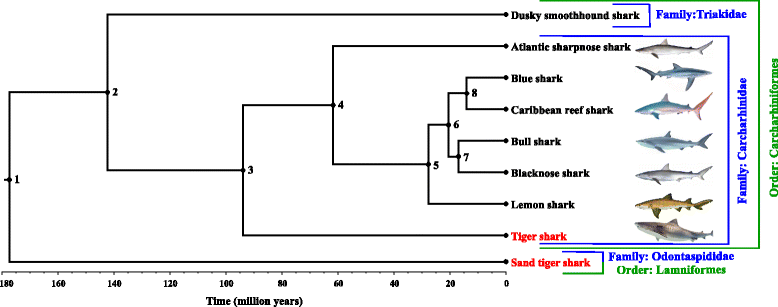Evidence of positive selection associated with placental loss in tiger sharks
- PMID: 27296413
- PMCID: PMC4906603
- DOI: 10.1186/s12862-016-0696-y
Evidence of positive selection associated with placental loss in tiger sharks
Abstract
Background: All vertebrates initially feed their offspring using yolk reserves. In some live-bearing species these yolk reserves may be supplemented with extra nutrition via a placenta. Sharks belonging to the Carcharhinidae family are all live-bearing, and with the exception of the tiger shark (Galeocerdo cuvier), develop placental connections after exhausting yolk reserves. Phylogenetic relationships suggest the lack of placenta in tiger sharks is due to secondary loss. This represents a dramatic shift in reproductive strategy, and is likely to have left a molecular footprint of positive selection within the genome.
Results: We sequenced the transcriptome of the tiger shark and eight other live-bearing shark species. From this data we constructed a time-calibrated phylogenetic tree estimating the tiger shark lineage diverged from the placental carcharhinids approximately 94 million years ago. Along the tiger shark lineage, we identified five genes exhibiting a signature of positive selection. Four of these genes have functions likely associated with brain development (YWHAE and ARL6IP5) and sexual reproduction (VAMP4 and TCTEX1D2).
Conclusions: Our results indicate the loss of placenta in tiger sharks may be associated with subsequent adaptive changes in brain development and sperm production.
Keywords: Carcharhinids; Elasmobranchs; Galeocerdo; Placenta; Positive selection; RNA-Seq; Reproduction; Transcriptome; Viviparous.
Figures

Similar articles
-
Complete mitochondrial genome of the tiger shark Galeocerdo cuvier (Carcharhiniformes: Carcharhinidae).Mitochondrial DNA. 2014 Dec;25(6):441-2. doi: 10.3109/19401736.2013.809450. Epub 2013 Jul 2. Mitochondrial DNA. 2014. PMID: 23815318
-
Lack of multiple paternity in the oceanodromous tiger shark (Galeocerdo cuvier).R Soc Open Sci. 2018 Jan 17;5(1):171385. doi: 10.1098/rsos.171385. eCollection 2018 Jan. R Soc Open Sci. 2018. PMID: 29410842 Free PMC article.
-
Habitat geography around Hawaii's oceanic islands influences tiger shark (Galeocerdo cuvier) spatial behaviour and shark bite risk at ocean recreation sites.Sci Rep. 2018 Mar 21;8(1):4945. doi: 10.1038/s41598-018-23006-0. Sci Rep. 2018. PMID: 29563552 Free PMC article.
-
High microplastic and anthropogenic particle contamination in the gastrointestinal tracts of tiger sharks (Galeocerdo cuvier) caught in the western North Atlantic Ocean.Environ Pollut. 2024 Mar 1;344:123185. doi: 10.1016/j.envpol.2023.123185. Epub 2023 Dec 24. Environ Pollut. 2024. PMID: 38147950 Review.
-
Reproductive Science in Sharks and Rays.Adv Exp Med Biol. 2019;1200:465-488. doi: 10.1007/978-3-030-23633-5_15. Adv Exp Med Biol. 2019. PMID: 31471806 Review.
Cited by
-
Phylotranscriptomics suggests the jawed vertebrate ancestor could generate diverse helper and regulatory T cell subsets.BMC Evol Biol. 2018 Nov 15;18(1):169. doi: 10.1186/s12862-018-1290-2. BMC Evol Biol. 2018. PMID: 30442091 Free PMC article.
-
Sequencing and characterization of the complete mitochondrial genome of Japanese Swellshark (Cephalloscyllium umbratile).Sci Rep. 2017 Nov 10;7(1):15299. doi: 10.1038/s41598-017-15702-0. Sci Rep. 2017. PMID: 29127415 Free PMC article.
-
Identification of Genes under Positive Selection Reveals Differences in Evolutionary Adaptation between Brown-Algal Species.Front Plant Sci. 2017 Aug 15;8:1429. doi: 10.3389/fpls.2017.01429. eCollection 2017. Front Plant Sci. 2017. PMID: 28861104 Free PMC article.
-
Bridging disciplines to advance elasmobranch conservation: applications of physiological ecology.Conserv Physiol. 2019 May 15;7(1):coz011. doi: 10.1093/conphys/coz011. eCollection 2019. Conserv Physiol. 2019. PMID: 31110763 Free PMC article.
-
Retrospective genomics highlights changes in genetic composition of tiger sharks (Galeocerdo cuvier) and potential loss of a south-eastern Australia population.Sci Rep. 2022 Apr 21;12(1):6582. doi: 10.1038/s41598-022-10529-w. Sci Rep. 2022. PMID: 35449439 Free PMC article.
References
-
- Blackburn DG. Convergent evolution of viviparity, matrotrophy, and specialisations for fetal nutrition in reptiles and other vertebrates. Am Zool. 1992;32:313–321. doi: 10.1093/icb/32.2.313. - DOI
-
- Wourms JP, Lombardi J. Reflections on the Evolution of Piscine Viviparity. Am Zool. 1992;293:276–93. doi: 10.1093/icb/32.2.276. - DOI
-
- Grogan ED, Lund R. Superfoetative viviparity in a Carboniferous chondrichthyan and reproduction in early gnathostomes. Zool J Linn Soc. 2011;161:587–594. doi: 10.1111/j.1096-3642.2010.00653.x. - DOI
-
- Blackburn DG: Evolution of Vertebrate Viviparity and Specializations for Fetal Nutrition: A Quantitative and Qualitative Analysis. J Morphol 2014: In Press. - PubMed
-
- Mossman HW. Vertebrate Fetal Membranes: Comparative Ontogeny and Morphology; Evolution; Phylogenetic Significance; Basic Functions; Research Opportunities. New Brunswick, NJ: Rutgers University Press; 1987.
MeSH terms
LinkOut - more resources
Full Text Sources
Other Literature Sources
Research Materials
Miscellaneous

